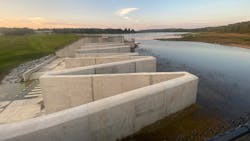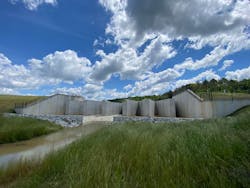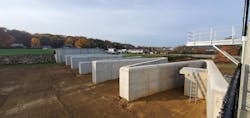Somerset Lake Dam rehabilitation project prioritizes safety
Somerset Lake is a 253-acre impoundment owned by the Commonwealth of Pennsylvania and managed by the Pennsylvania Fish and Boat Commission (PFBC). The lake and its surrounding watershed support a variety of wildlife, including fish, turtles, ducks, geese, blue heron, egrets and other birds, and is also a viewing spot for bald eagles. Residents and visitors enjoy boating, kayaking and paddle boarding as well as fishing for a variety of species.
A major feature of Somerset Lake is the original earthen dam. The original dam has been classified as high hazard, meaning there would be potential loss of life downstream if the dam were to unexpectedly fail. In January 2012, the lake level was lowered by approximately six feet after state dam safety inspectors documented excessive seepage. Following an engineering evaluation and investigation it was determined that the existing dam was not in compliance with current dam safety regulations, which set into motion plans to address the existing dam. An additional drawdown took place in October 2017 to prepare for construction activity. A period of relaxed fishing regulations and a large-scale fish salvage took place to remove or relocate most of the fish population. Following this program, the lake was officially closed to public fishing and boating in April 2018 and fully drained in September 2019.
Michael Baker International provided engineering services to PFBC for rehabilitation of Somerset Lake Dam. Services included an assessment of the existing structure, design and construction administrative services. Project improvements involved construction of a new labyrinth spillway, raising the top of the dam, adding a toe berm, adding seepage filter protection measures and making improvements to the control tower and lake drain system used to control the water level.
Overcoming project obstacles
Technical challenges encountered during the project included critical issues identified during geotechnical investigation. Sand seams were determined to exist under the dam without a proper cutoff. This led to the identified uncontrolled seepage observed through the dam and standing water and wetland formation downstream. To resolve the issue, Michael Baker installed a robust chimney and blanket drain along the re-constructed embankment to collect seepage through and under the dam. Slotted collection pipes and weir boxes were installed to monitor seepage through the dam. A toe berm was installed over the blanket drain, providing necessary weight to counteract artesian pressures to reduce the heave potential along the toe. Piezometers were installed along the dam to monitor the water pressures within the dam and foundation soils.
Artesian conditions along the left abutment were also discovered during the subsurface exploration. The on-site drainage and spillway improvements were designed to mitigate excess head pressures and potential high-exit gradients. Michael Baker also collaborated with the contractor to develop a temporary water control system with berms and bypass pumping to safely divert water around the work area so the spillway could be constructed in the dry. The new labyrinth spillway was anchored into the underlying bedrock to counteract the artesian conditions on the left abutment.
In addition to sand seams and artesian conditions, the existing spillway and dam embankment were insufficient to store and safely convey the Probable Maximum Flood (PMF) for the dam without overtopping the embankment. Furthermore, the embankment and spillway did not meet stability requirements. To address the issue, Michael Baker designed a labyrinth spillway (zig-zag shaped structure) to replace the existing structure, providing more hydraulic capacity that requires a smaller footprint than traditional spillways with similar capacity. To minimize project costs, the embankment was raised by four feet, providing additional storage capacity and offsetting the need for a large spillway.
Safety first
The design and rehabilitation of the dam required adherence to strict dam safety guidelines. The new spillway and raised earthen embankment provide the necessary spillway and storage capacity to convey the PMF event through the spillway without overtopping. The overall width of the spillway was minimized by increasing the effective length of the weir. In lieu of reconstructing the earthen embankment, a chimney and embankment drainage system were incorporated to lower phreatic surfaces through the dam. This solution allowed a majority of the embankment to remain in-place and provided a significant cost-savings to the owner.
The final design complied with Pennsylvania Department of Environmental Protection (PADEP) Dam Safety requirements. Michael Baker provided construction management oversight to confirm that the construction was conducted in accordance with the drawings and specifications.
Upon completion
Somerset Lake has been identified as a Biological Diversity Area in the Somerset County Natural Heritage Inventory and great care was taken throughout design and construction to reduce impacts to nature and wildlife. It is an important bird area due to its bird diversity with more than 250 documented species, including nesting osprey and waterfowl migrations in spring and fall. In addition, it boasts one of the best fishing opportunities in the state of Pennsylvania. With the new dam up and running, PFBC fisheries biologists have begun to carry out a restocking plan for the lake, which previously contained a large population of largemouth bass, walleye, channel catfish, crappies, sunfish, perch, muskellunge, tiger muskellunge, northern pike, bowfin, gizzard shad, golden shiner and common carp.
The rehabilitation of the Somerset Lake Dam is helping to ensure the lake remains an important social destination and economic driver for the region. The project proved that a wise infrastructure investment can make endless ripples into its community and the dam improvements are already inspiring nearby upgrades around Somerset, including a five-mile trail around the lake.
About the Author
Edward Kaminski
Edward Kaminski, P.E., is project manager, Surface Water, at Michael Baker International. Kaminski can be reached at [email protected].
Brian Afek
Brian Afek, P.E., is department manager of Water Resources at Michael Baker International. Afek cam be reached at [email protected].




